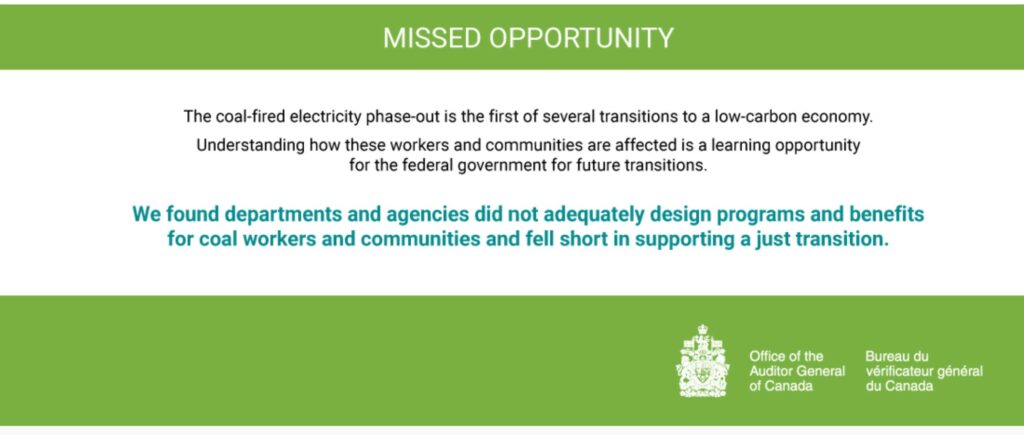“Just Transition” isn’t “Just”
It’s anything but just…
On June 15 (just days before the House rises for the summer) the government tabled their ‘Just Transition’ legislation – rebranded as Bill C-50 The Canadian Sustainable Jobs Act. The legislation is based closely on a report released in May which I studied thoroughly and previously wrote about. Here is my analysis of that report and the government’s overall strategy to transition oil and gas workers out of a responsible and prosperous industry into … well … something else.
Amongst the myriad of issues that are being thrown into disarray by initiatives the government is pursuing, this one seems not even half-baked. It’s as though they were in a rush to push something onto the agenda, without even considering the words they put on paper, and their connection with reality.
The Government prepared a 32-page ‘brief’ on the initiative, and it is overflowing with aimless narratives and virtuous slogans.
I took the effort to break down the nonsense. Let me summarize my findings:
The government is looking for a solution to a problem they can’t define.
Here’s how they approach their objective:
- “The formal definition of sustainable jobs will remain evergreen in order to evolve over time through consultation with key partners and the public”
- They then brazenly state that Canada will not be short of jobs – particularly in the energy industry.
So, they’re taking this on for what reason?
The big ticket, of course, as with all of the aimless initiatives put forth by the government, is the desire to spend taxpayer funds.
- $250 million for a new Sustainable Jobs Secretariat
- Create a Sustainable Jobs Partnership Council
- Duplicate much activity currently being performed by provincial ministries of labour and advanced education.
Here’s just one of the absurdities about how it is going to spend the allotted funds:
- Improve labour market data collection, tracking and analysis
- Identify what data is currently tracked across the federal government and other accessible sources.
Honestly, they’re going to look at the data they are already looking at, that they don’t know they have. This is a resource allocation decision.
I performed some analysis on the last federal government program of this nature, ‘The Just Transition for Coal Workers and Communities’
- $185 million was allocated to communities who transitioned from coal power plants for a 7 year period ending 2025
- To date, $52 million has been spent in 53 projects (less than a third, 5 years into a 7-year program)
- $27 million was spent in Alberta
- $18 million of that on a road in Nisku that is nowhere near any coal mines or miners
How were the other funds spent?
- Transition plans; local area development plans; transition staff; consultant reports.
- 83% of funds went to municipalities and consultants, not workers.
Yes, this is just a slush fund
Hanna, Alberta was a key target – how did it fare?
- Unemployment rose from 4% to 10%
- Average house values fell from $177,000 to $65,000
So, the affected workers did not do so well
Lots of paper-writing and consoling about job losses. No tangible outcomes for workers.
Let’s agree that the federal government has proven to be really bad at this ‘Just Transition’ thing.
Talk is easy, but execution is not part of this government’s skill set.
“The government is not prepared to provide appropriate support to more than 50 communities and 170,000 workers in the fossil fuel sector.”
Jerry V. DeMarco, Commissioner of the Environment and Sustainable Development, June 7, 2022

Thousands of Alberta workers, who today have good paying jobs in a responsible industry, are at risk of losing those jobs to a government that has no realistic plan to transition them to the lauded “green jobs” with promised “higher salaries”.
The average oilsands worker makes $98/hour (2021); the average “clean-tech job” clocks in at $48/hour. Replacing the lost incomes could only be done with the aid of huge taxpayer subsidies – if the government manages to do it at all.
Contributing to the government’s pressure on oil and gas workers is other legislation already in place. Most notably, Bill C-69.
The Impact Assessment Act (Bill C-69) is one of this government’s signature pieces of legislation from the last Parliament. It’s been ruled by the Alberta Court of Appeal to be unconstitutional legislation, and we are awaiting the Supreme Court of Canada’s decision on what appears to be a federal overstep.
- Let’s look at how they are fulfilling their role in this new regulation:
- For claims that it would bring certainty of timelines to the regulatory process, exactly the opposite has been experienced.
Again, the narrative is easy; but the results are not there.
This is a jurisdictional overstep
- Canada is a constitutional federation, and responsibilities for matters that are more local – such as having a post-secondary education system preparing work forces for the jobs of the future – have always been delivered by provincial authorities.
- The Supreme Court has indicated that overlap of this nature is not consistent with their interpretation.
We have to ask, ‘why does this federal government want to unilaterally move into provincial jurisdiction?’ Central planning economies do not work in a country as broad and diverse as Canada.
The conclusion of my analysis is that a proposal that begins this badly has a very remote chance of demonstrating a successful outcome.
Related material